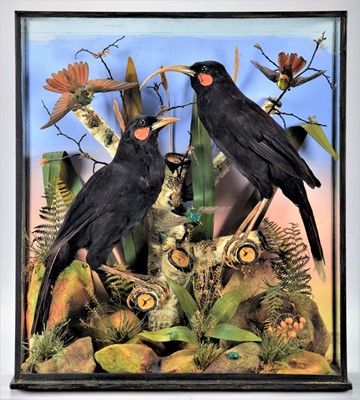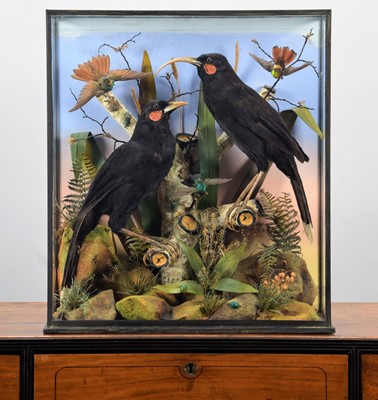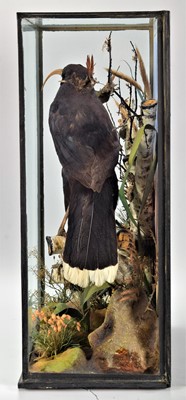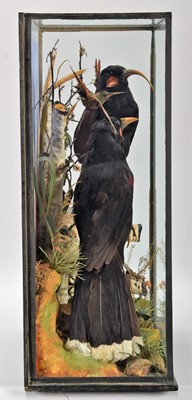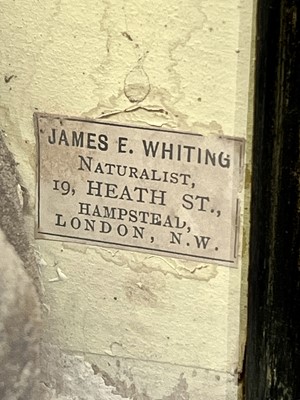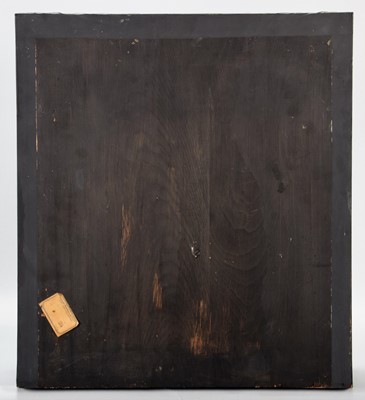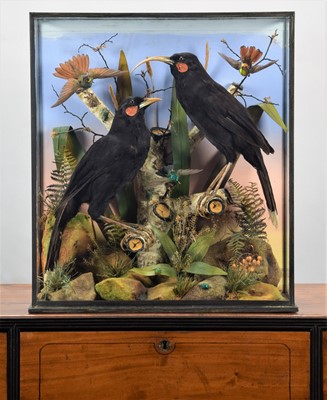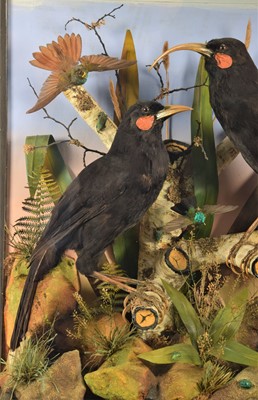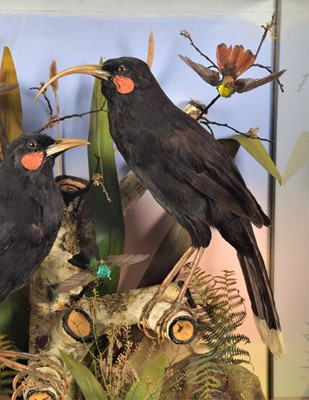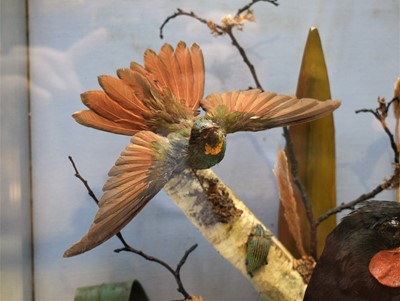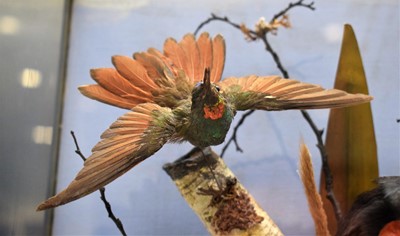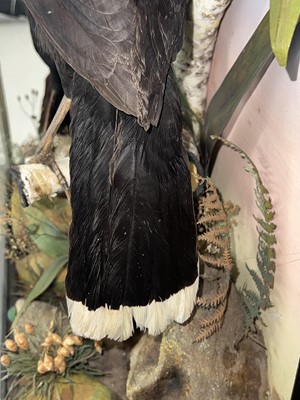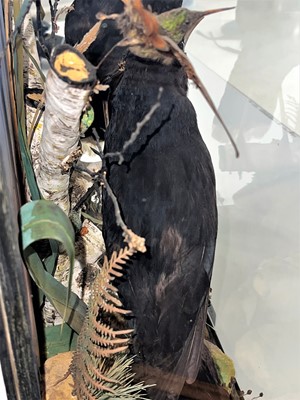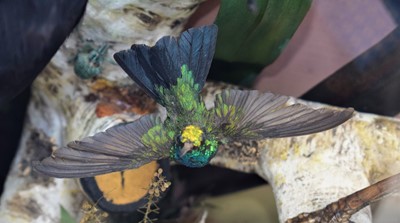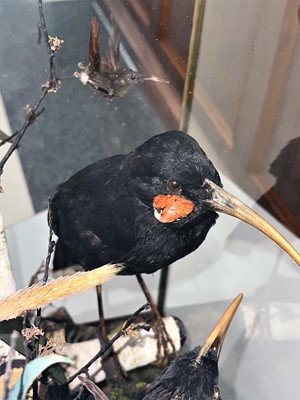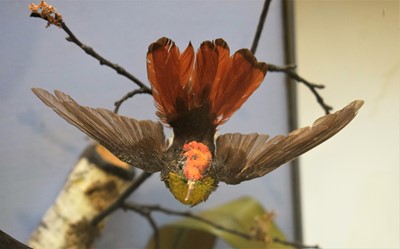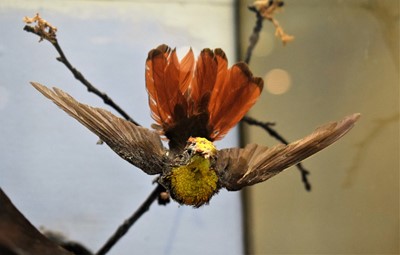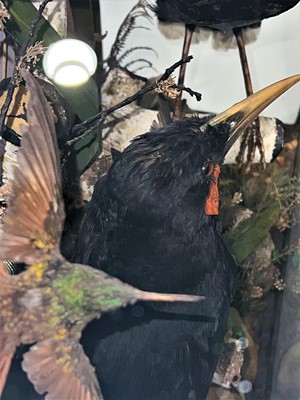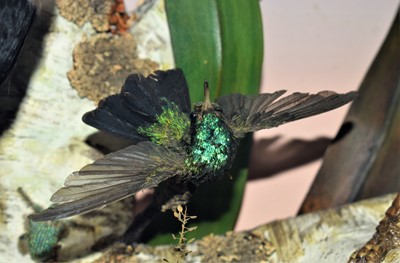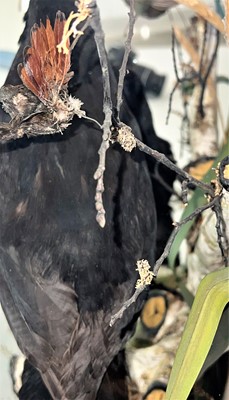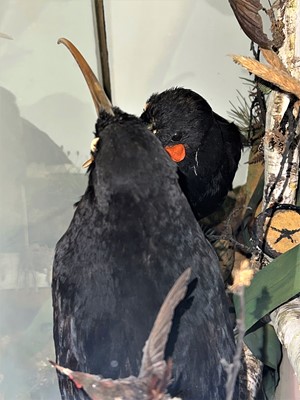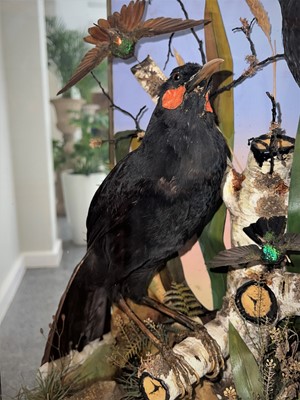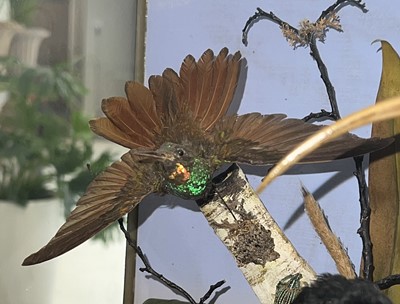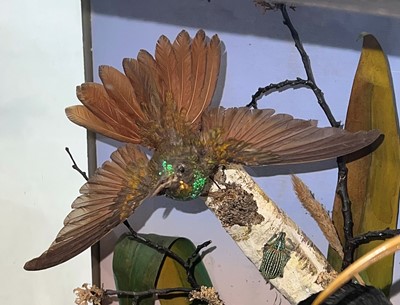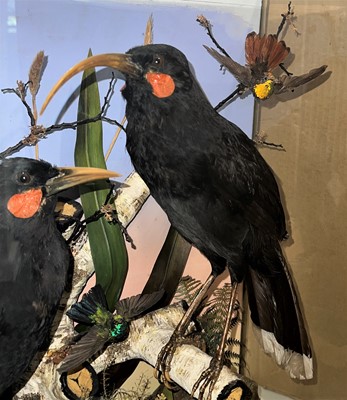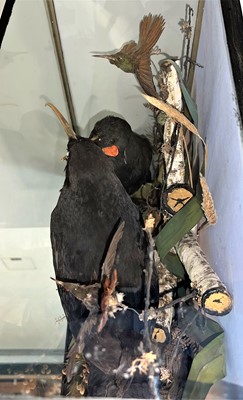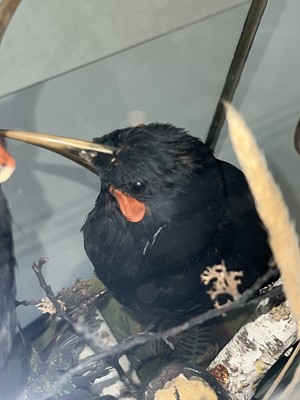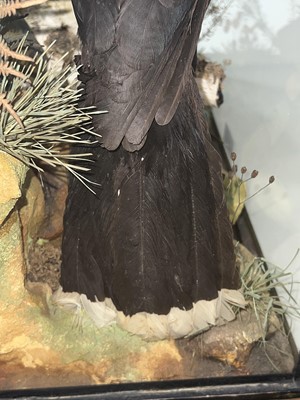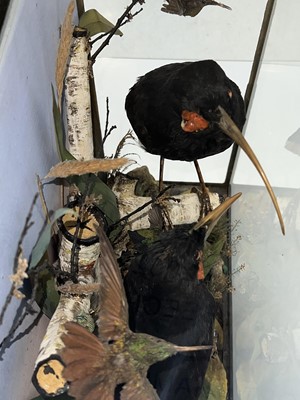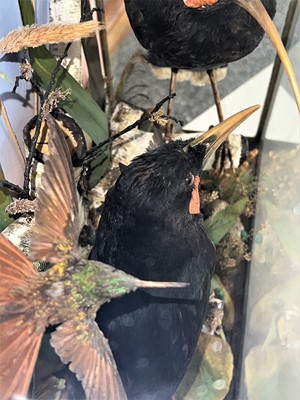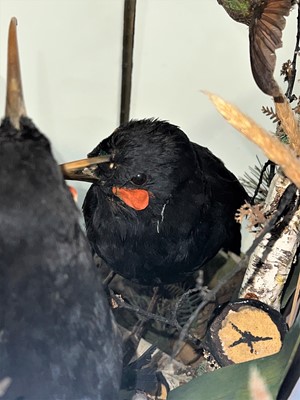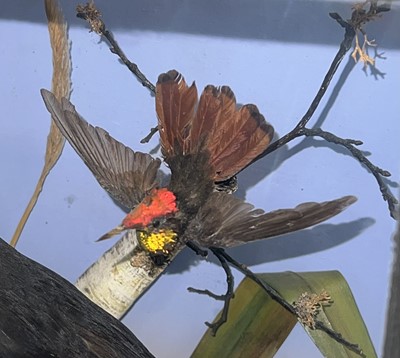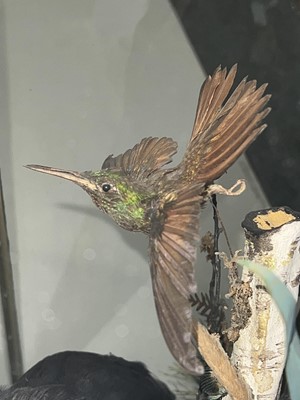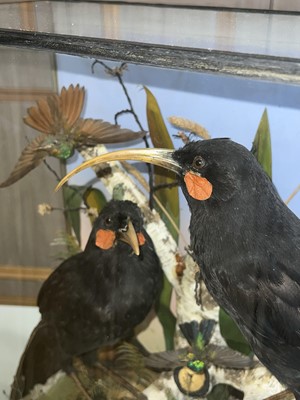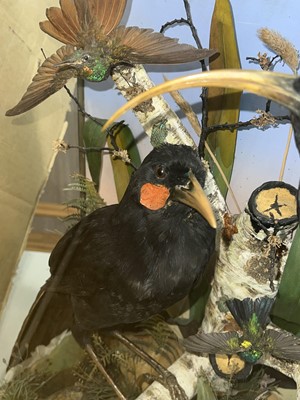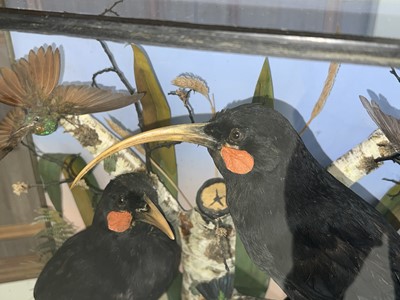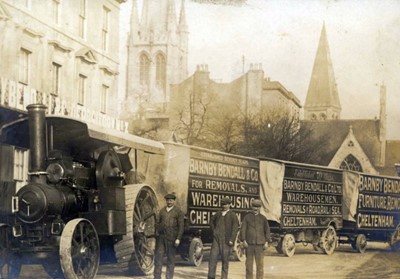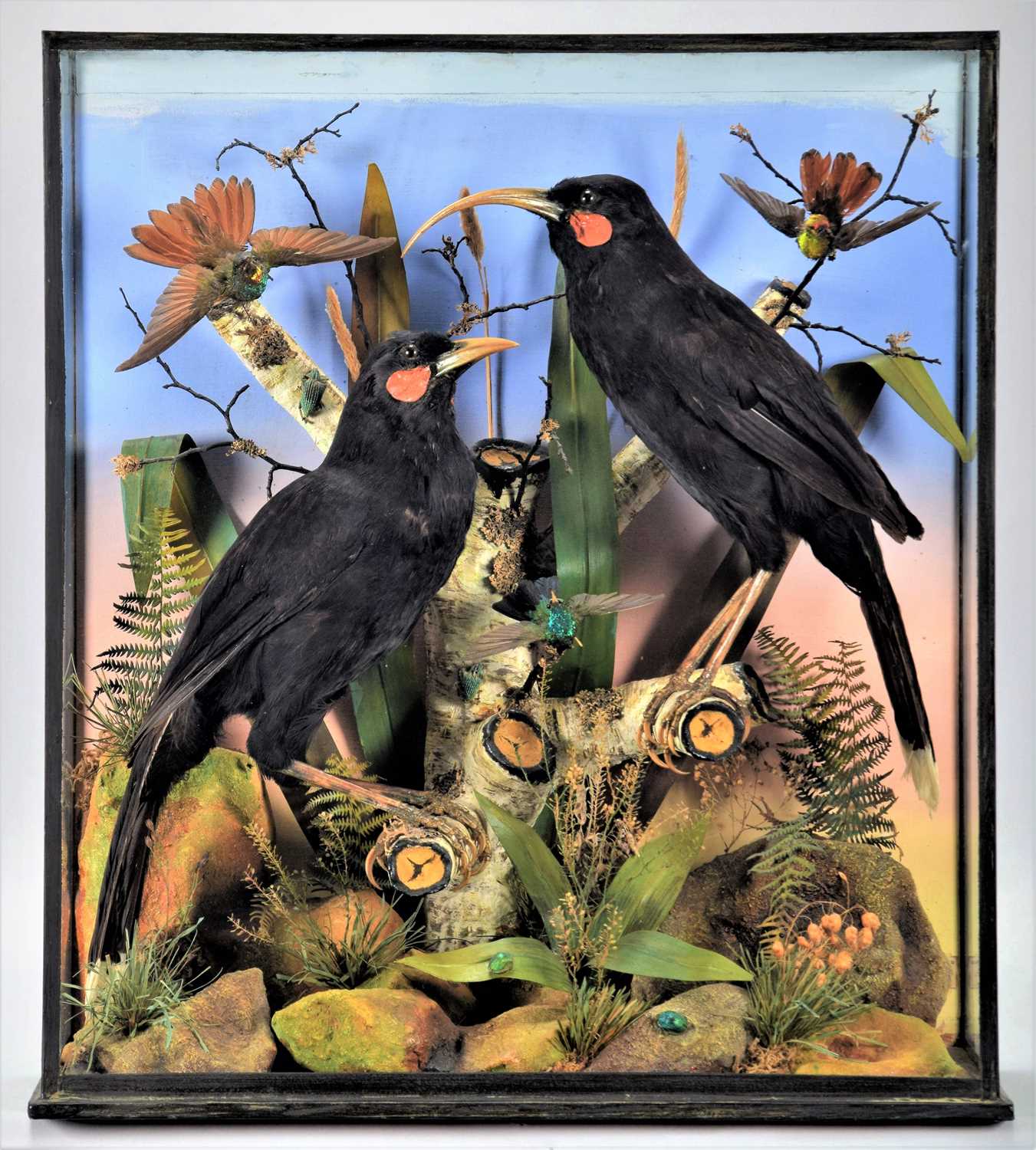8th Sep, 2023 10:30 GMT/BST
Natural History & Taxidermy
382
Taxidermy: A Cased Pair of Extinct New Zealand Huias (†Heteralocha acutirostris), circa late 19th century, by James E. Whiting, Naturalist 19 Heath St, Hampstead, London, a pair of superb quality full mount adults, the female perched slightly above the male, both perched upon a centrally positioned simulated tree branch, three colourful hummingbirds to the centre, upper right, and left, mounted amidst enhanced natural flora, grasses, ferns and fauna, above painted faux rocks to the groundwork, set against a graduated blue and pink sky back drop, enclosed within a four-glass table display case, 46.5cm by 21cm by 53cm, bearing taxidermist's full paper trade label to interior lower right.
The Huia birds extinction had two primary causes. The first was rampant overhunting to procure huia skins for mounted specimens and their tail feathers for hat decorations. The second major cause was the widespread deforestation of the lowlands of the North Island by European settlers to create pasture for agriculture. Most of these forests were ancient, ecologically complex primary forests, and huia were unable to survive in regenerating secondary forests.
It was already a rare bird before the arrival of Europeans, confined to the Ruahine, Tararua, Rimutaka and Kaimanawa mountain ranges in the south-east of the North Island. It was remarkable for having the most pronounced sexual dimorphism in bill shape of any bird species in the world. The female's beak was long, thin and arched downward, while the male's was short and stout, like that of a crow. Males were 45 cm (18 in) long, while females were larger at 48 cm (19 in). The sexes were otherwise similar, with orange wattles and deep metallic, bluish-black plumage with a greenish iridescence on the upper surface, especially about the head. The tail feathers were unique among New Zealand birds in having a broad white band across the tips. The last confirmed sighting of a huia was in 1907, although there was a credible sighting in 1924.
James Edmund Whiting was born in Steeple Claydon Buckinghamshire in 1848. He moved to Welbeck, Nottinghamshire, and worked as a plumber according to the 1871 census, not appearing again until 1891 when he is living at 41 Heath Street, Hampstead, working as a taxidermist, the same in 1901. By 1911 he is based at 5 South Street, Hampstead, still working as a taxidermist. He died at his home, Spaniards Road, Hampstead in 1930 aged 82 years.
Sold for £220,000
Estimated at £15,000 - £25,000
All glass has been historically replaced, back board i feel has also been replaced at some point in time possibly when the glass was replaced, re-taped around 20 years ago, our client has owned this case for the last 42 years, bearing Barnaby Bendall Depository label to verso, this company went out of business circa 1962 therefore any restoration would have been carried out prior to being placed in storage with this company, 22/05/23
We are happy to provide Condition Reports to Prospective Buyers, but would welcome your request as soon as possible, preferably at least 48 hours before the Day of Sale.
We cannot guarantee a reply to any requests made within 48 hours of the start of the auction. The absence of a condition report from a lot does not mean that the lot is in perfect condition.
A Condition Report is an honest expression of our opinion, not a statement of fact and is provided as a service to the Seller. All lots are available on public view ahead of an auction and we encourage people to see an item in person when possible.
Our Condition Reports are not prepared by professional conservators, restorers or engineers, and are prepared with the naked eye unless otherwise stated.
Works are not examined out of the frame, unless specifically stated. We accept no liability for the opinions expressed in any Condition Report.
Tennants Auctioneers do not cover damage to gilded wood or plaster picture frames, or to picture frame glass whilst the item is in our possession.
Auction: Natural History & Taxidermy, 8th Sep, 2023
A very rare Victorian cased pair of extinct New Zealand Huia leads the Natural History and Taxidermy Sale. The superb quality male and female huia full mounts were mounted by James E. Whiting, Naturalist, of 19 Heath Street, Hampstead, and are presented perched on a branch and surrounded by hummingbirds, rocks and foliage.
Also on offer in the sale are a Monumental Late Victorian Cased Display of Tropical Birds Native to South America & South East Asia & Oceana, circa 1870-1900 (estimate: £8,000-12,000), an impressive large late Victorian cased White Pelican and White Ibis mounted in 1879 by James Gardiner (estimate: £3,000-5,000), a fine cased diorama of Eurasian Bullfinches by T.E. Gunn, Naturalist of Norwich (estimate: £700-900), an early 20th century Giant Clam Shell (estimate: £500-700), and a modern re-creation of a Toco Toucan by the renowned taxidermist Carl Church of Pickering, North Yorkshire (estimate: £1,500-2,500).
Viewing
Thursday 7th September 10am-5pm and the morning of the sale from 8am
Sell one like this
If you've got a similar item to sell, complete the valuation form below and one of our experts will get in touch.
